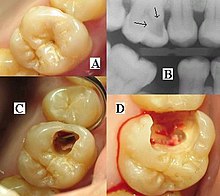RADIOGRAPHIC FEATURES OF DENTAL CARIES
§Carious lesions are detectable radiographically when there has been enough demineralization to allow it to be differentiate
from normal.
§Radiographic examinations include;
1. Bitewing radiographs (most common technique used)
2.Periapical radiographic technique ( second chioce after bitewing)
3. radiographs using paralleling technique
4. Dental panoramic tomograph













